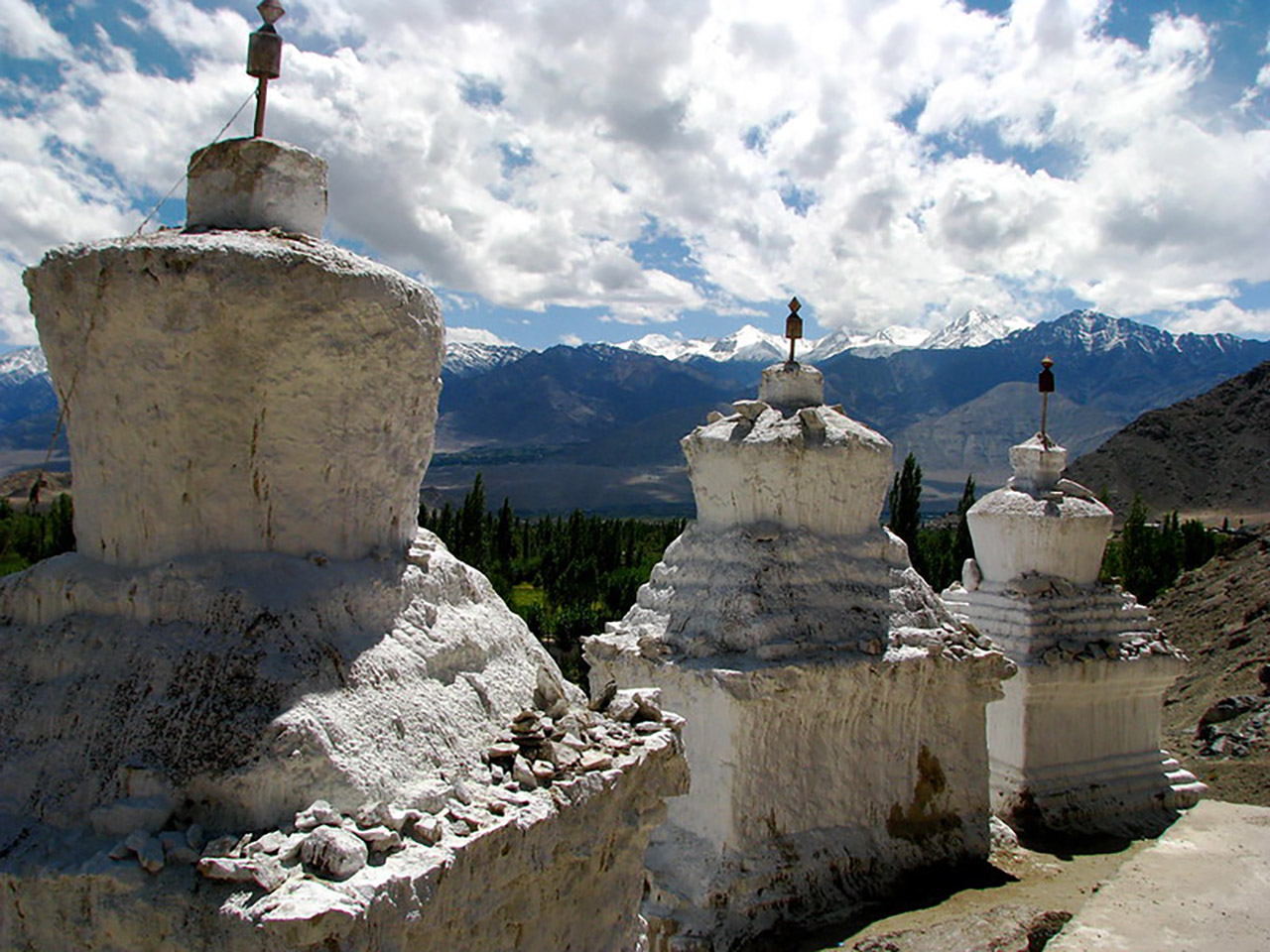
A stupa, meaning heap or a pile is a shrine or a reliquary that contains sacred remains of Buddhist monks and nuns or other holy persons. The hemispherical structure with a spire at its top is also used as a place of meditation by Buddhist monks. These sacred sites are dedicated to the Buddha and the Buddhist saints. One can always find a pradakshina path around the stupas which is a pathway made of stone where devotees walk clockwise around the shrine as a ritual. The shape of the stupa represents the Buddha in a meditative posture sitting on a lion throne, crowned. Let’s take a look at some great in India:
1. Sanchi Stupa, Madhya Pradesh

The Buddhist complex, Sanchi is famous for its Great Stupa which is one of the most famous stupas in India. The Great Stupa (Mahastupa) is situated on a hilltop at Sanchi in Madhya Pradesh, India, and is considered one of the oldest stone structures in the country. The monument is very valuable, important, and the best-preserved ancient stupa. Its construction was commissioned by Ashoka the Great and he along with his wife supervised the work. He even constructed one of the pillars which are inscribed with his proclamation. The famous sandstone pillar of Ashoka is still at the complex in Sanchi. Toranas, the free-standing arched gateways are intricately engraved. The hemispherical stone had a ‘chatra’ which intended to honor and shelter Buddha’s relics. The Sanchi Stupa is a UNESCO World Heritage Site and is also featured on the rear side of the 200 rupees note.
2. Dhamekh Stupa, Sarnath
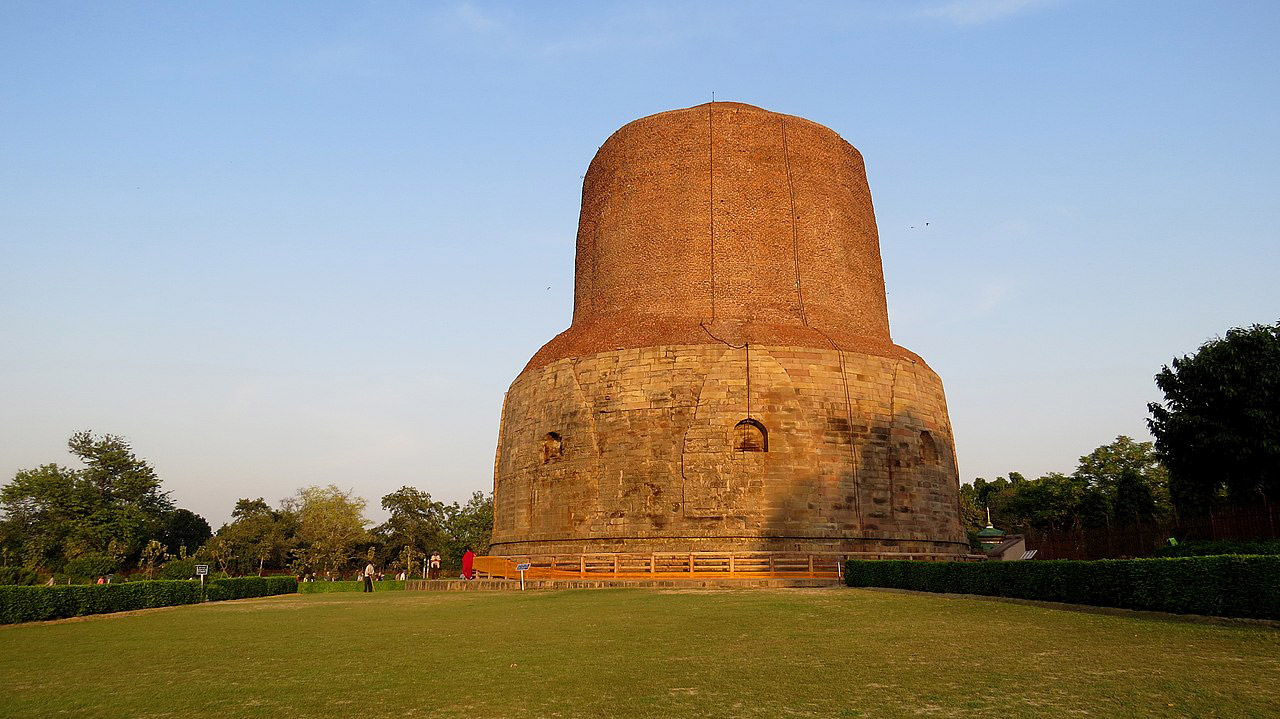
Located at Sarnath, Uttar Pradesh, the Dhamekh Stupa is a massive structure, originally built in 249 BCE and later reconstructed in 500 CE. It was commissioned by Ashoka the Great, who wanted to enshrine the relics of Buddha and his disciples. There is an Ashoka pillar with engraved edicts standing on the site. The Dhamekh stupa is an exquisite piece of Buddhist architecture and is engraved with birds, flowers, humans, and inscriptions in Brahmi script. The shape is a strong cylinder of bricks and stones with a diameter of 28 meters and a peak of 43.6 meters. The Stupa is believed to mark the spot of a deer park where Lord Buddha delivered his first sermon after attaining enlightenment in Bodh Gaya. The panels of the stupa also have ‘Swastikas’ on them.
3. Amaravati Stupa, Andhra Pradesh
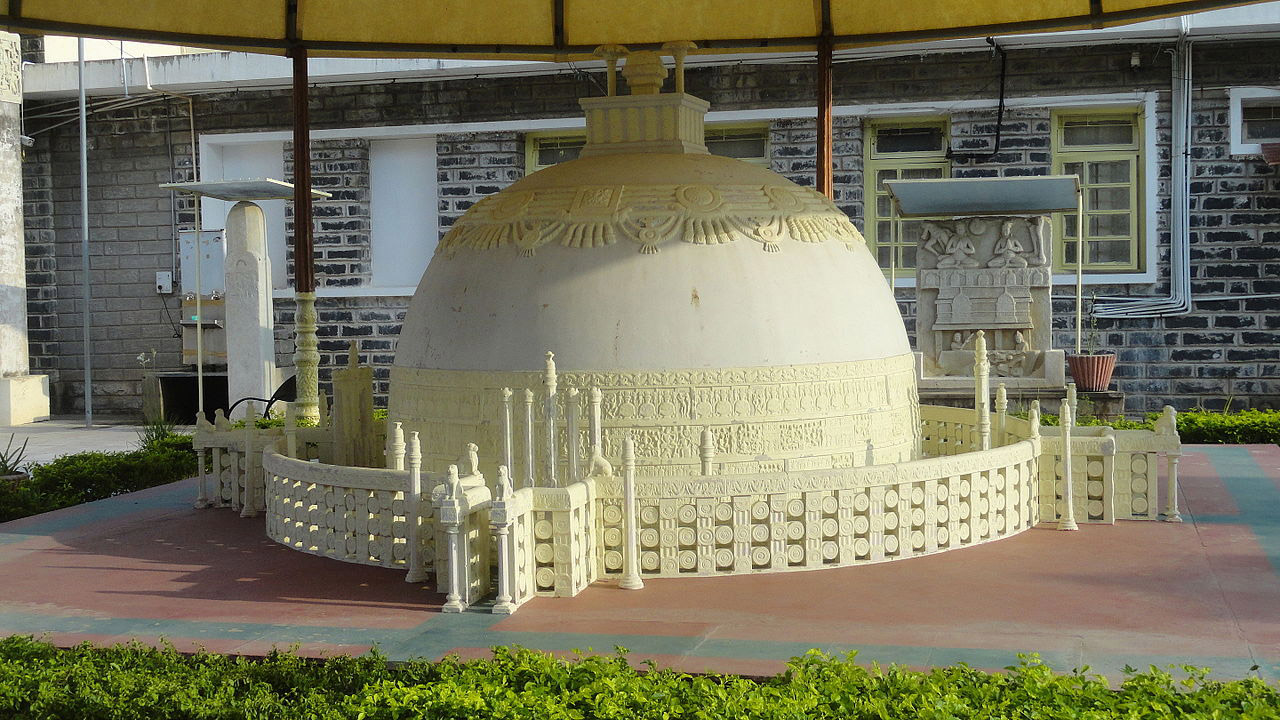
The Amaravati Stupa or Mahastupa at Amaravathi village in Guntur, Andhra Pradesh is one of the finest monuments with stunning architecture and a diameter of about 50 meters and a height of 27 meters. Built during the reign of Ashoka in 200 CE, the Stupa has a circular vedika that portrays Lord Buddha on top of an elephant. The stupa was called a Mahachaitya in ancient inscriptions. It is an important spot for Buddhism as the Vajrayana teachings of Kalachakra are practiced here. The stupa was neglected and was buried under dust and debris but some of its relics, sculptures, and inscriptions that depict the life of Lord Buddha are preserved in several museums. There are a few broken pillars that remain at the site for significance and past glory of the stupa.
4. Shanti Stupa, Leh
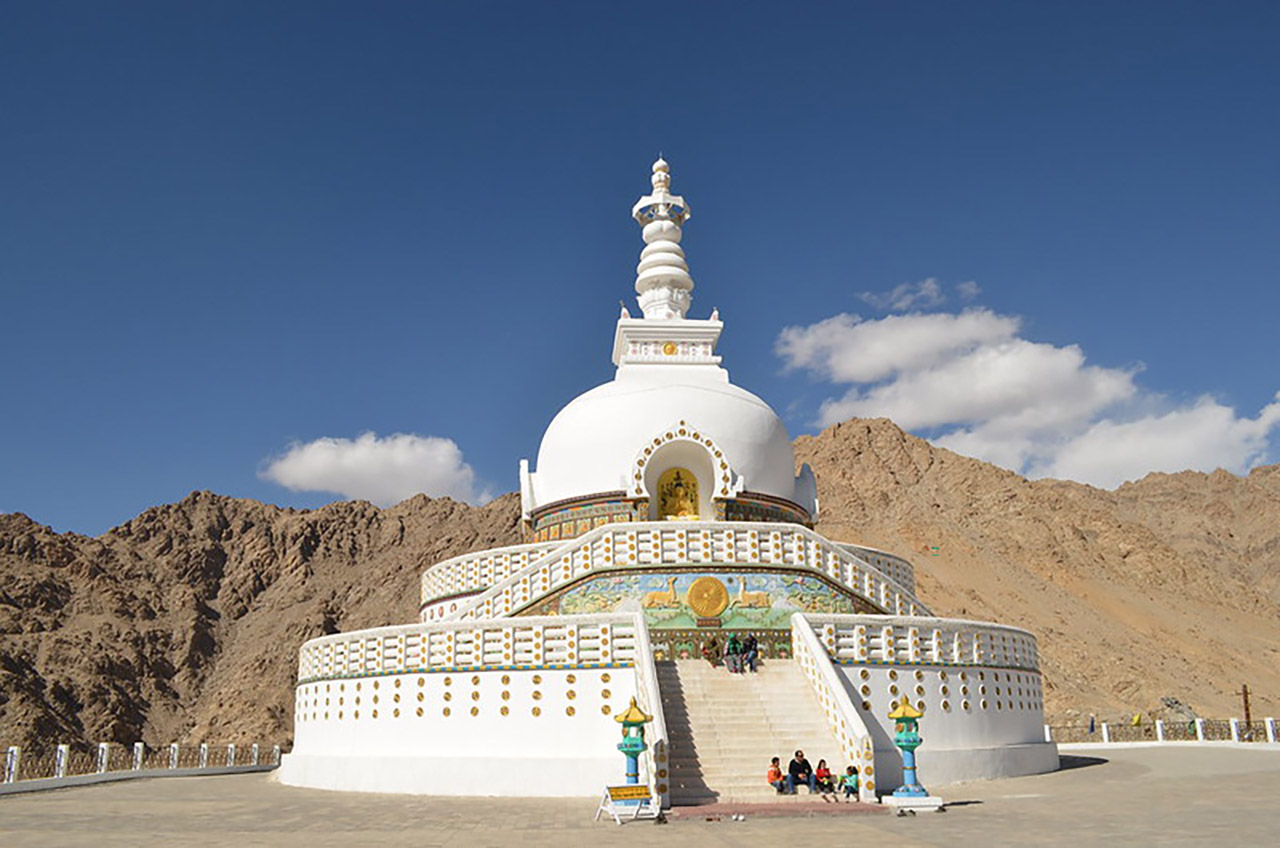
Located on the hilltop of Chanspa in Leh, Ladakh, this white-domed Buddhist Shanti Stupa was built in 1991 by Japanese and Ladakh Buddhists to promote world peace and also commemorate 2500 years of Buddhism. It has Lord Buddha’s relics at its base which were preserved by the 14th Dalai Lama, who also inaugurated the stupa in August 1991. Due to its location, the stupa offers panoramic views of the nearby landscape and surrounding mountain ranges making it a major tourist attraction. The stupa is a two-level structure, where the first level has the central relief of Dharmachakra with deer on each side and a golden Buddha image sitting on a platform. The second level depicts the birth and death of Buddha and Buddha vanquishing devils while meditating. Sunrise and sunset is the best time to visit the stupa and one also has to climb 500 steps to reach the monument.
5. Bavikonda Stupa, Andhra Pradesh
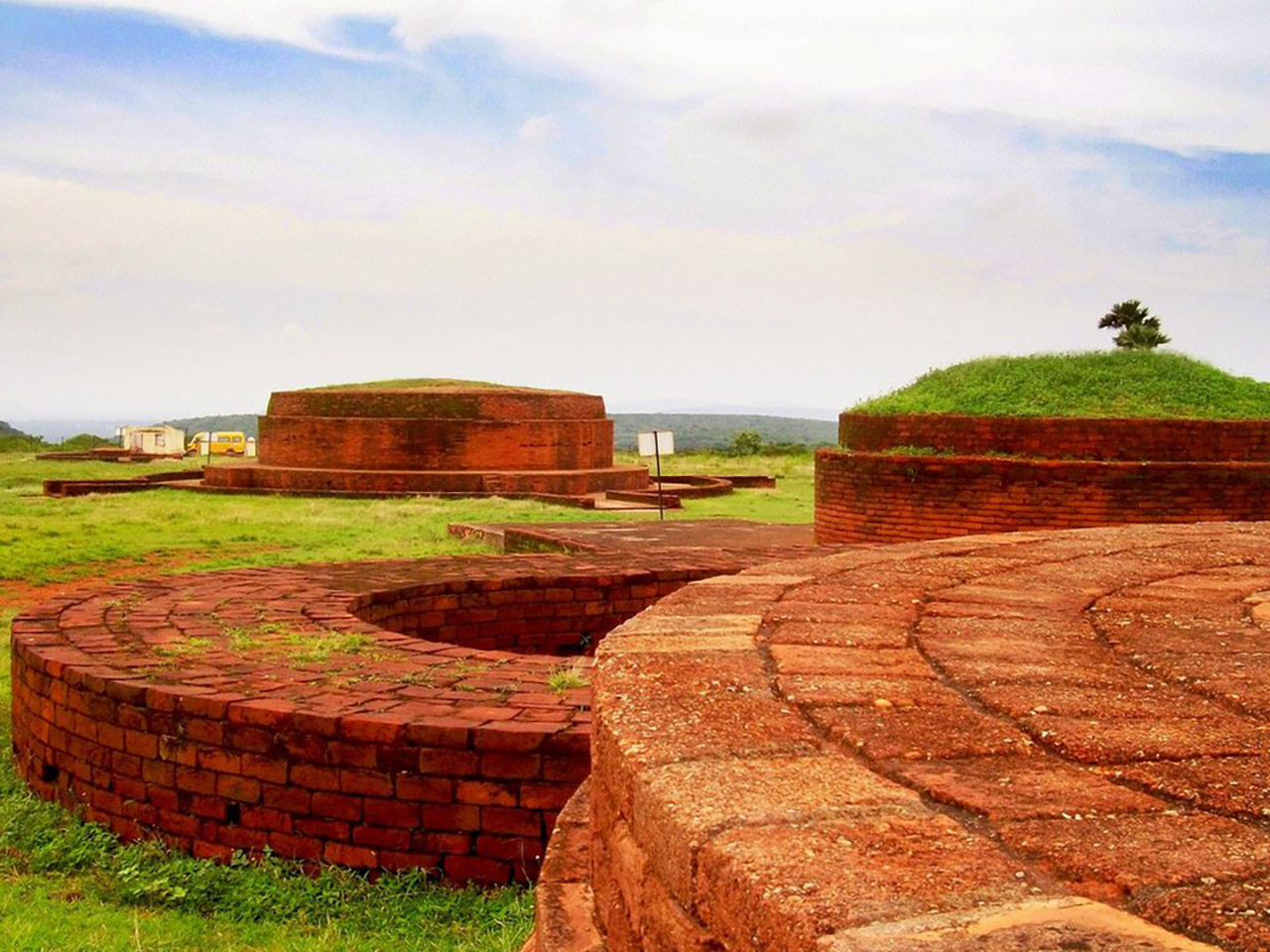
Located at a distance of 16 km from Visakhapatnam, Andhra Pradesh, the Bavikonda Buddhist Complex is situated about 130 meters above mean sea level on a hill. Bavikonda is also known as the hill of wells as the place has many wells for rainwater collection. This Buddhist complex is an excavated site and it contains numerous relics which date back to the 3 rd century BCE. The excavated remnants included remains of Buddha, pottery, bricks, coins, caskets, inscriptions, etc. which were recovered by the State Archaeological Department. Bavikonda along with three other places is a heritage site by UNESCO.
6. Chaukhandi Stupa, Sarnath
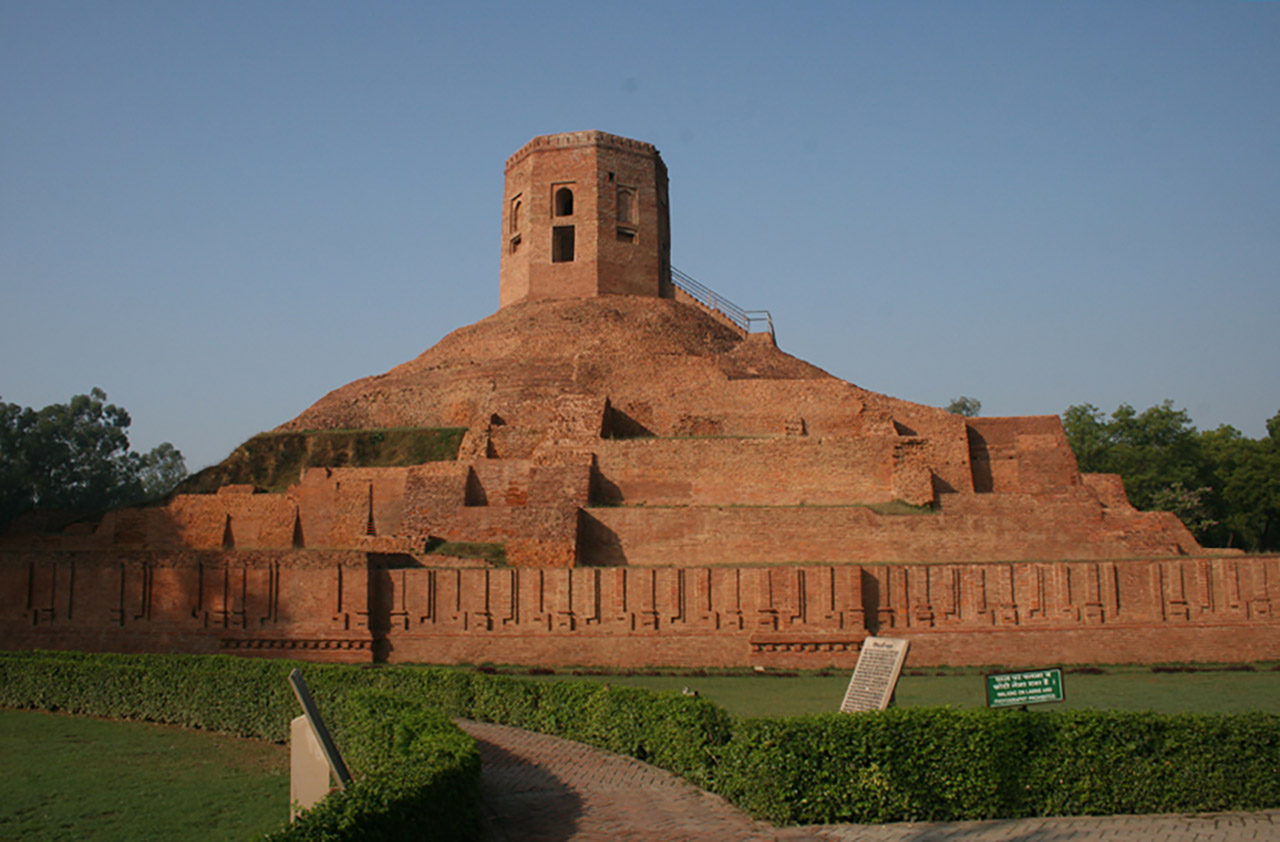
The Chaukhandi Stupa in Sarnath, Varanasi, Uttar Pradesh was initially built as a terraced temple between the 4th and 6th centuries to mark the area where Lord Buddha met his first disciples on their journey from Bodh Gaya to Sarnath. Afterward, Raja Todar Mal’s son redesigned the stupa and built the octagonal tower to celebrate the visit of Mughal ruler, Humayun. However, the stupa became declared a monument of countrywide significance in June 2019. The stupa is a high earthen mound with brickwork all over it and the place is surrounded by lush gardens and museums.
7. Kesaria Stupa, Bihar
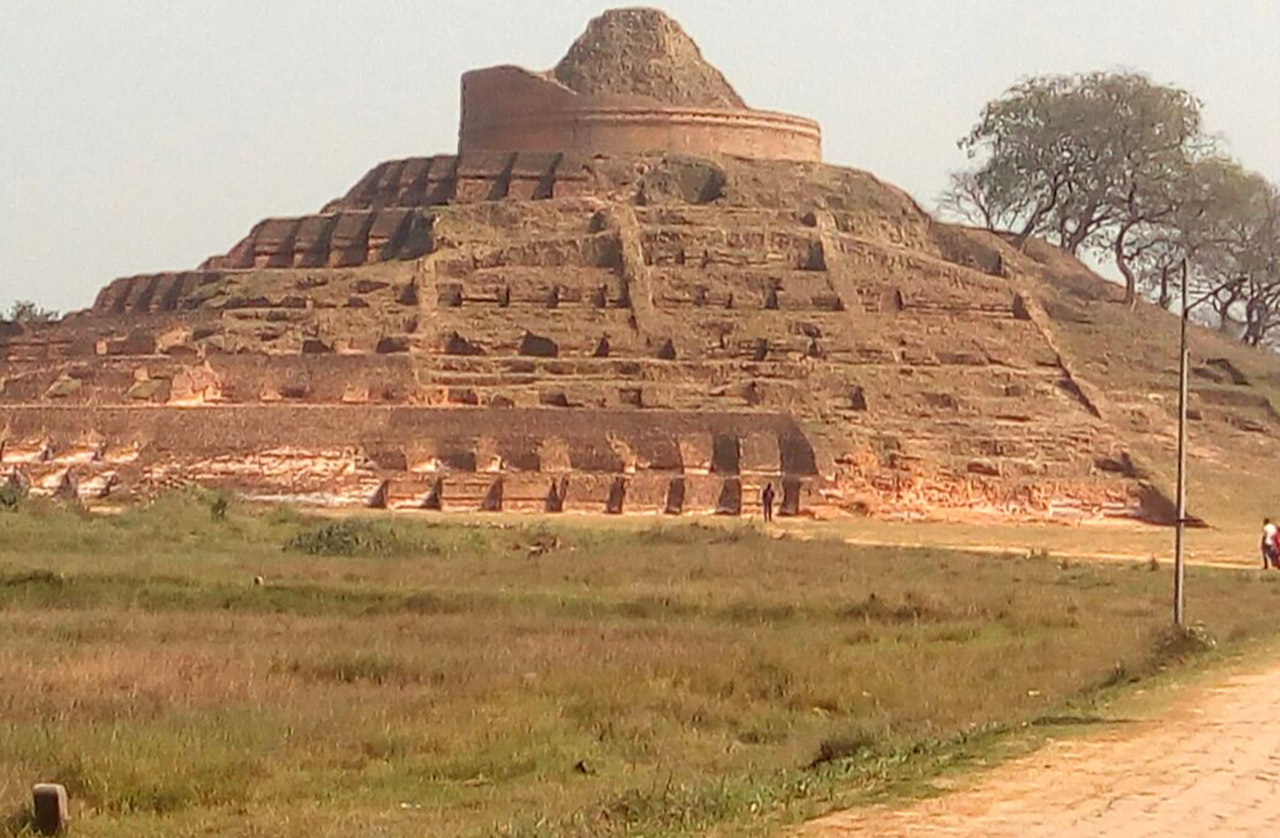
Located in Champaran (east), Bihar and at a distance of one hundred ten kilometers from Patna, this Buddhist stupa is one of the tallest and biggest Buddhist stupas in the world. The Kesaria Stupa is a 104 feet tall structure with a circumference of almost 400 feet. The original height of the stupa was 150 feet but after the 1934 Bihar earthquake, the structure was reduced to its present height. It is said that the stupa dates back between 200 AD and 750 AD. The Kesaria Stupa was excavated in 1998. It is also called ‘Devala’ meaning ‘house of god’ by the local people. It is also believed that Lord Buddha visited Kesaria to preach the Kesaputtiya Suttas which included the Kalama Sutta. The stupa is now a protected monument of national significance.
8. Ramabhar Stupa, Kushinagar
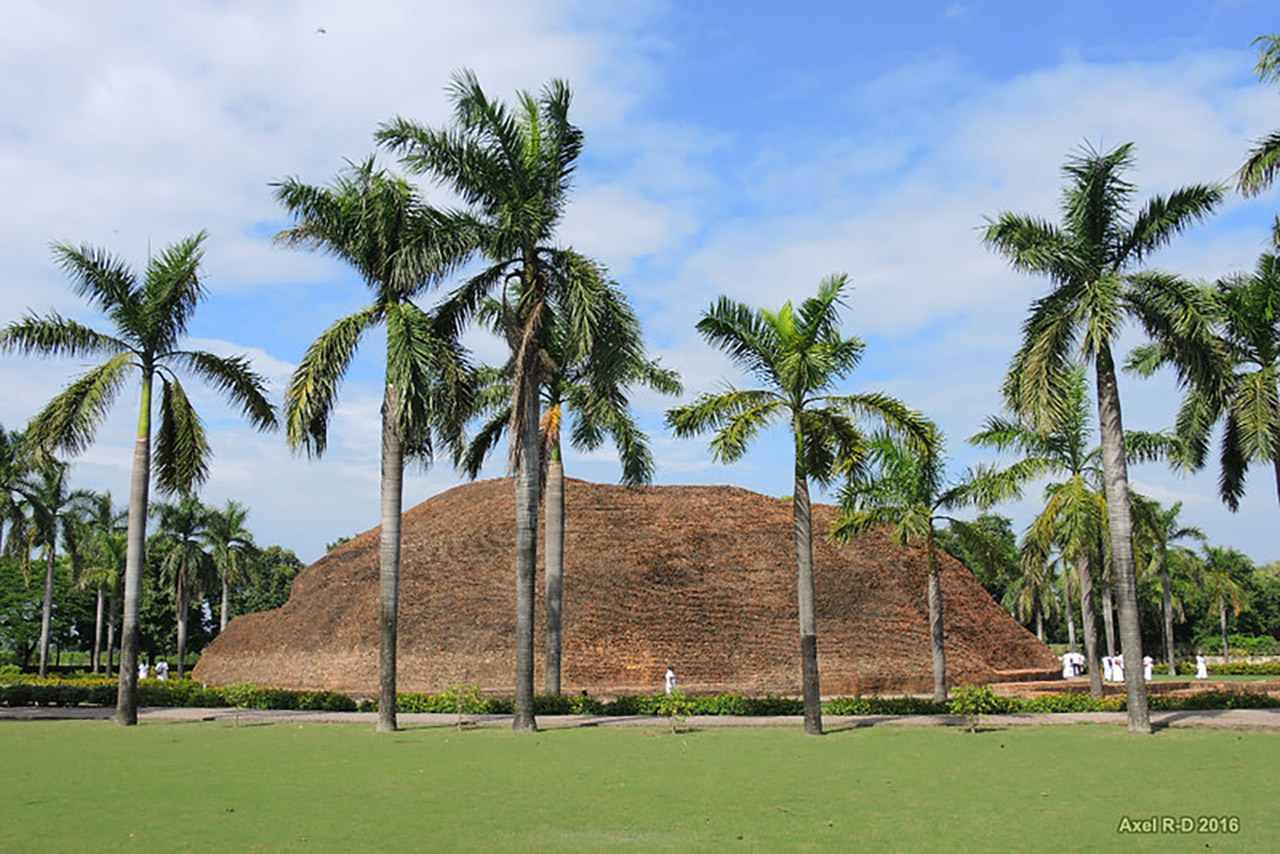
The Ramabhar Stupa in Kushinagar, Uttar Pradesh is one of the most sacred and important Buddhist pilgrimage sites. This is the place where Lord Buddha was cremated in 483 BC. It is believed to have attained Parinirvana after death. The stupa is dome-shaped having brickworks with a height of 49 feet. It is also called the Mukutbandhan-Chaitya. Lord Buddha also gave his last sermon to his disciples at this place. It was, “impermanence is inherent in all things. Work out your salvation with diligence”. There are ruins from the pre-historic era near the stupa. There is also a pond-like water body close to the monument.
9. Angulimala Stupa, Shravasti

The Angulimala’s Stupa in Shravasti, Uttar Pradesh is another site that was excavated along with the Shravasti city in 1863. Shravasti was a new city created for Lava, Lord Rama’s son according to the epic Ramayana. The city was also called Savatthi according to the Buddhist tradition as the sage Savattha lived there. Shravasti was a major religious site for Buddha’s disciples. It is said that Lord Buddha spent his monastic years here at the Jetavana Monastery. Angulimala was a ruthless dacoit in Shravasti who chopped other’s fingers and wore them in a necklace around his neck. He was once about to kill his mother. Lord Buddha turned him into a disciple and showered him with wisdom. The remains of the stupa are known as Pakki Kuti. Only the walls, a plinth, and a raised platform with a flight of stairs are there at the spot.
10. Buddha Stupa, Deur Kothar
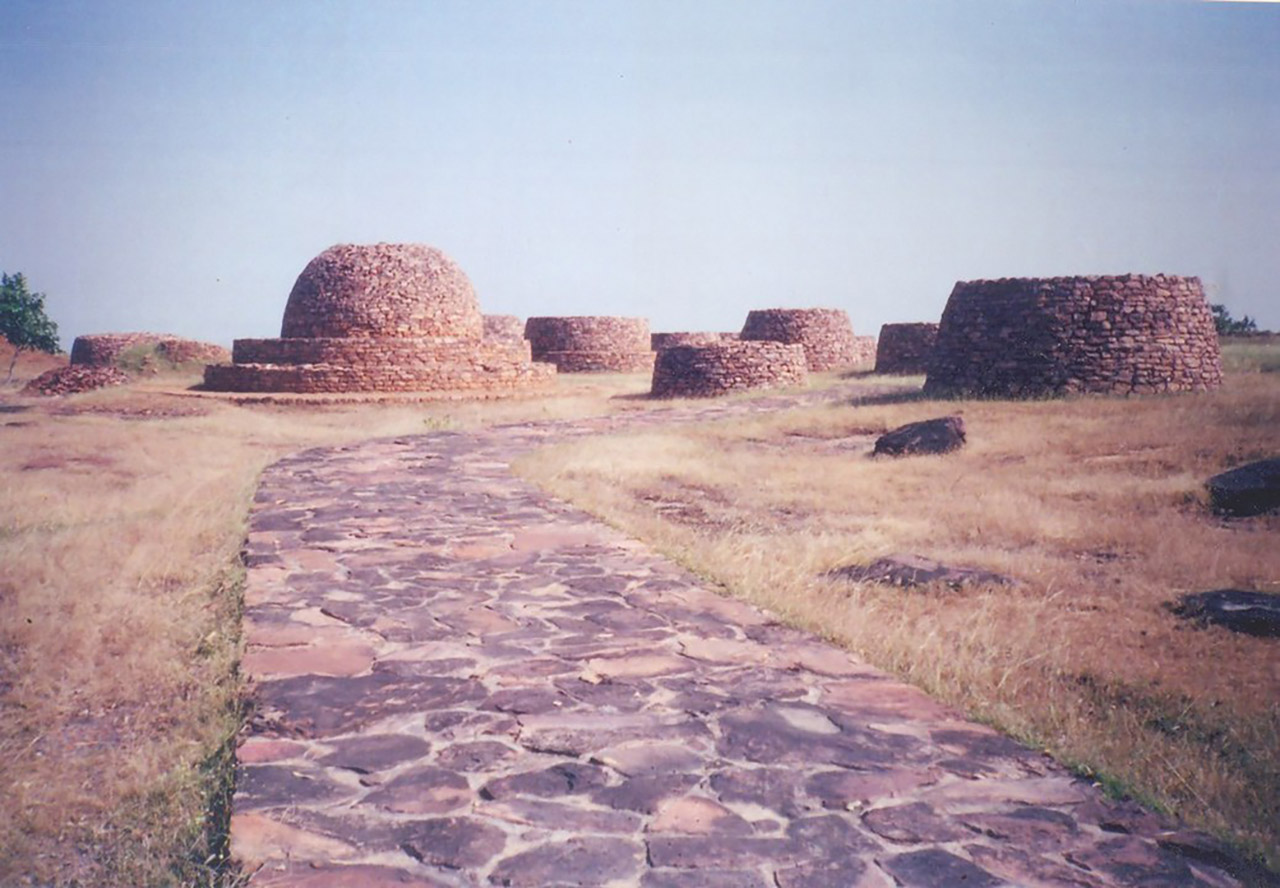
Deur Kothar or Deorkothar in Madhya Pradesh is known for its Buddhist stupas. This place is of archaeological as well as national importance and was discovered in 1982. This excavated site contains remains of various monuments made of stones and bricks. The entire complex was constructed by Ashoka the Great. It contains monasteries, an ancient pathway, elaborately carved pillars with Brahmi inscriptions, a water channel system, and 40 stone stupas. These stupas were established by King Ashoka in the 3rd century BCE. The complex is also known for four brick stupas.








It is a rare discovery by an eminent Archaeologist Dr PHANIKANTA MISHRA RETD REGIONAL DIRECTOR ASI PRESENTLY HE IS DIRECTOR HERITAGE CELL MAKAUT KOLKATA. ONE MUST GO AND SEE THE DETAIL DESCRIPTION OF THE SITE ON MAKAUT.BLOG .THIS SITE WAS MISSED BY CUNNINGHAM. IT NEED TOTAL DEVELOPMENT OVERALL.STUPA SITE IS NOT BEING PRESERVED VERY WELL BY ASI JABALPORE CIRCLE
Hey Yashi, thanks for the info…
systematic excavations were undertaken during the year 1999- 2001 by the Archaeological Survey of India, under the directorship of Dr. Phani Kanta Mishra. The most imposing structure exposed during the excavation was Stupa 1 (over 9 m high). Stupa 1 and 2 were exposed with the view to exposing the sequence of events on the basis of structural and stratigraphical remains. Besides, it aims to ascertain the extant structures and disjointed architectural members for the purpose of future conservation. Both the stupas were covered by a blanket of brickbats above the medhi level and tapering away from them. the site needs protection under Dr. Misra. ASI should see that. here is a list of publications. 1. Jeeban Kumar Patnaik Noor Bano Sattar, Glory of Archaeology, Art, Epigraphy and Protection of Cultural Heritage, (Dr. Phanikanta Mishra Felicitation Volume), Kaveri Books, New Delhi, 2016
2. Oskar von Hinüber, Oskar and Peter Skilling, “Two Buddhist Inscriptions from Deorkothar (Dist. Rewa, Madhya Pradesh).” Annual Report of the International Research Institute for Advanced Buddhology Vol. XVI, at Soka University 16: 13-26 , Tokyo, 2013.
3. Phani Kanta Mishra. 2001. ‘Deorkothar Stupa: New Light on Early Buddhism.’ Marg 52(1): 64–74
—–. 2001 (unpaginated). Discovering the Past: Bhojpur, Bhimbetka, Deorkothar. Bhopal: Archaeological Survey of India, Bhopal Circle.
—–. No date (unpaginated). Deorkothar (Barhat), Rewa: A Unique, Recently-Excavated Buddhist Site in Central India. Bhopal: Archaeological Survey of India, Bhopal Circle. Nakanishi
4. Richard SALOMON and Joseph MARINO, Observations on the Deorkothar Inscriptions and Their Significance for the Evaluation of Buddhist Historical Traditions, Annual Report of the International Research Institute for Advanced Buddhology, Vol. XVII, Soka University Tokyo, 2014.
5. Upinder Singh, A HISTORY OF ANCIENT AND EARLY MEDIEVAL INDIA
FROM THE STONE AGE TO THE 12TH CENTURY, Pearson, Delhi